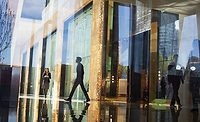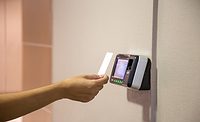Balancing Perimeter Security and Visitor Management






Thief! Intruder! Birdwatcher? Sometimes, perimeter security puts you in contact with a variety of visitors, not all of them welcome, but how does one differentiate between visitors without making a bad first impression or creating a vulnerable situation? And how does that situation change based on a facility’s location and risk profile? Three security executives weigh in on the issue.
“Perimeters are in place to deter or delay any unauthorized access, whether that’s for theft, damage, graffiti – there are lots of motivations to enter port facilities,” says Dennis Treece, CSO for the Massachusetts Port Authority. “There are non-malicious reasons for trespass too. Sometimes a birdwatcher wants to get closer to the water or a tourist wants a better photo of a plane.” But perimeters have to work for all of them, he says.
But while airports and seaports traditionally have strict perimeter controls, college campuses often prove difficult to secure at the border. When Jeff Karpovich, CPP, took over as the Chief of Security and Director of Transportation at High Point University in 2008, he aimed to change that.
High Point University has been the site of immense growth over the past decade: 42 buildings have been added in the past seven years, and the campus has expanded from 90 acres to more than 300. And, Karpovich says, security has not been left behind. During his tenure, the security department has grown from 12 members to more than 70.
“We’re very proactive here. Our philosophy is to invest on the front end, which can drive marketing and growth for the university,” he says. “When I was hired, I embarked on an effort to build up our perimeters. We started with lighting then physical barriers, such as the signature fencing along the main campus edge and automatic gates at most entrances.”
But because campuses, by nature, have to be hospitable as well as secure, High Point built welcome centers at permanent entries and deployed mobile observation posts, or MOPs, at temporary portals.
“In almost every case, the security officer at the welcome center or MOP is the first encounter for every guest to your institution,” Karpovich says. “That’s why they aren’t guard shacks or watchposts; they are welcome centers. It’s a chance to make a really good first impression.”
However, the posts aren’t just for putting on a good front.
“The officers can’t be just lumps on a log,” Karpovich adds. “They have to observe the visitor’s behavior and follow the SAFE protocol.” SAFE is one of Karpovich’s favorite acronym approaches to security: Stand, Assess, Face, Engage. By following the procedure, even for regular visitors such as staff or students, the officer maintains a level of consistency and connection with the guest, as well as enabling a polished reception, not a confrontation.
“The concerns at the perimeter don’t often change,” says Treece. “There’s no new threat on the horizon, and we’re not likely to see one. The problem is maintaining vigilance – staying motivated and keeping troops sharp.”
Karpovich employs “secret shoppers” to test the security at each welcome center to ensure that the officers are staying on-the-ball in terms of both security and guest relations. And while the campus remains open from 6 a.m. to 10 p.m. daily and people may enter for no reason, they will still be “lightly vetted” at the welcome centers. After-hours, visitors at the gates will be present their ID or guest log-in information (registered online by the visited person).
Similarly, for intruders and guests, Treece recommends keeping reports of every incident – marking, if possible, the name and description of the intruder. If the same birdwatcher or photographer is found on the grounds 50 times, perhaps there’s a more serious threat there, he says. Keeping reports can help security officers keep tabs on who has been there before.
At Navistar International Corporation, a manufacturer of International brand commercial trucks and more, Director of Global Security John Martinicky makes sure that every guest is thoroughly vetted throughout the day through the Easy Lobby badging program, which is installed on 35 workstations at 20 Navistar locations around the world.
“We used to not use visitor management and tracking systems, so we were surprised at all of the additional information we get from the program,” says Martinicky. “Our headquarters in Lisle, Ill., got 50,000 visitors last year with the program. Plus, it’s useful for monitoring our foreign visitors, giving us a key metric and allowing Navistar to be compliant with a number of programs.”
The business has more than 100 locations worldwide, including offices, dealerships and manufacturing facilities in North and South America, South Africa, Asia and India.
“We have to reduce our risk profile by location,” Martinicky says. “We limit access points and delivery areas to help guard materials that are prone to theft.” And while all of the locations have traditional staples of perimeter control – visitor management, access control, security video with digital recording – certain locales require different specialties.
“When we’re looking into a new facility, we perform a 125-point security audit of the building, then follow up with a CAP Index report,” he says. “We also profile the neighboring facilities to get an idea of what the area is like.” The security measures are adapted to the location, such as the addition of guard dogs in South Africa and increased patrols and sensors in certain facilities in Mexico.
“We have a good template, and we typically only modify it based on the geographical risk profile,” Martinicky adds. “We’re also using a security tracking and reporting system (STARS) to track incidents as well as responsibilities and tasks for security officers.”
Utilizing security officers at the border is also major factor in ports, as Treece is well aware.
“Technology can be a great force multiplier, but you’ll always need those people who can make decisions,” he says. “A smart camera can’t question a birdwatcher.”
Fencing is merely a delay tactic, Treece adds, not a full barrier. “A delay gives time for response. Some fences might buy you more time – such as anti-climb fences – but any tall ladder can defeat a fence,” he says.
Treece also suggests building a multi-layer system that involves multiple departments, especially law enforcement.
“Unfortunate as the circumstances are, stronger police outreach programs are one of the good things that came as a result of 9/11,” says Treece. Security officials should visit their local precinct, meet with the captain and talk about that organization’s environment and protocols, he says, especially now that cyber intrusions are becoming just as important as physical ones.
“Even with the FBI – they need to know who you are so they can share intelligence with you about your facility,” he adds.
“The more depth you put into a system, the more successful you’re going to be,” says Treece. “Murphy is out there and lurking, so you have to be prepared for the worst.”
This article was previously publsihed in the print magazine as "Enemy at the Gates: Addressing Friends and Foes at the Perimeter."
Looking for a reprint of this article?
From high-res PDFs to custom plaques, order your copy today!









